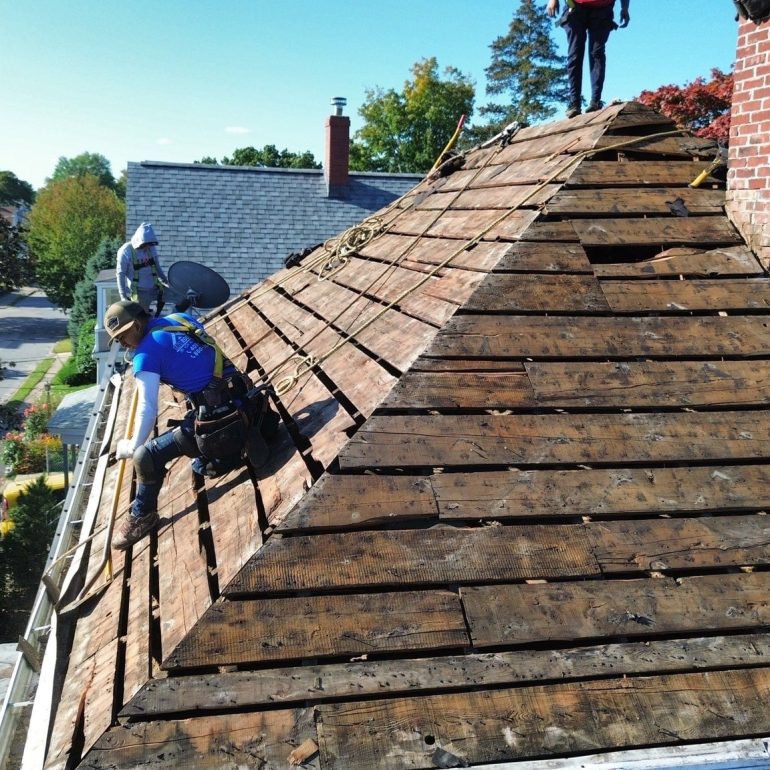Sagging gutters are more than just an eyesore – they’re a serious threat to your home’s foundation, siding, and overall structural integrity. When gutters begin to pull away from your roofline or develop noticeable dips and bends, immediate action is essential to prevent costly water damage. Understanding how to repair sagging gutters can save homeowners thousands in potential repairs while maintaining their property’s value and protection.
Whether you’re dealing with minor sagging or significant gutter failure, this comprehensive guide will walk you through the causes, solutions, and repair techniques needed to restore your gutter system’s functionality. From identifying early warning signs to implementing professional-grade fixes, we’ll cover everything you need to know about addressing this common yet critical home maintenance issue. If you’re in Cranston, RI, and need professional assistance, 757 Exteriors INC offers expert guidance and comprehensive solutions for all your gutter repair needs.
Understanding Why Gutters Sag
Gutter sagging doesn’t happen overnight – it’s typically the result of multiple factors working together over time. The most common culprit is improper installation, where gutters lack adequate support or have been installed with incorrect slope angles. When gutters aren’t properly pitched toward downspouts, water accumulates in sections, creating excessive weight that gradually pulls the system away from the fascia board.
Weather-related damage also plays a significant role in gutter deterioration. Heavy snow loads, ice dams, and severe storms can overwhelm even properly installed systems. Additionally, age and wear naturally weaken gutter materials and their supporting hardware, making older systems more susceptible to sagging issues.
For homeowners in Cranston, RI, and surrounding areas, 757 Exteriors INC has observed that debris accumulation is another leading cause of gutter problems. When leaves, twigs, and other materials block proper drainage, the resulting standing water creates weight stress that exceeds the system’s design capacity.
Key factors contributing to gutter sagging:
- Inadequate fastener spacing – Hangers placed too far apart
- Oversized gutter sections – Spans exceeding recommended lengths
- Damaged fascia boards – Rotted or weakened mounting surfaces
- Incorrect gutter pitch – Slopes that don’t promote proper drainage
- Heavy debris loads – Accumulated leaves, ice, and snow
Essential Tools and Materials for Gutter Repair
Before attempting any gutter repair project, gathering the right tools and materials is crucial for both safety and effectiveness. Safety equipment should be your first priority – invest in a sturdy extension ladder, non-slip shoes, and work gloves. Never attempt gutter work during wet or windy conditions, and always have someone spot you while working at height.
Basic repair tools include a cordless drill with various bits, a level for checking proper slope, and a measuring tape for accurate positioning. You’ll also need a hacksaw or reciprocating saw for cutting damaged sections, and a caulk gun for applying sealants. Having a bucket or tarp nearby for collecting debris will keep your work area clean and organized.
Material selection depends on your existing gutter system and the extent of damage. Replacement hangers should match your current hardware style, while gutter sealant should be compatible with your gutter material – whether aluminum, vinyl, or steel. Keep extra screws and brackets on hand, as damaged fasteners often need replacement during repair projects.
For homeowners considering complete system upgrades, professional gutter installation offers long-term solutions with proper engineering and materials.
Expert Tip: Safety First
Always inspect your ladder before use and maintain three points of contact while climbing. Position the ladder at a 4:1 ratio – for every 4 feet of height, the base should be 1 foot away from the wall. Never overreach; it’s safer to move the ladder frequently than risk a fall.
Step-by-Step Repair Process
Step 1: Assessment and Preparation Begin by thoroughly inspecting your entire gutter system from ground level, noting areas of obvious sagging, separation, or damage. Use binoculars if necessary to get a clear view of problem areas. Mark locations that need attention with spray paint or chalk on the ground below for easy reference once you’re on the ladder.
Step 2: Clean and Clear Remove all debris from the affected gutter sections before starting repairs. This includes leaves, twigs, sediment, and any standing water. A clean gutter allows you to properly assess the damage and ensures new hardware will seat correctly. Use a garden hose to flush out remaining debris and check for proper water flow.
Step 3: Realign and Support For minor sagging, you may only need to adjust existing hangers or add additional support. Gutter hangers should be spaced no more than 24 inches apart, with closer spacing in areas prone to heavy snow loads. When installing new hangers, ensure they’re fastened directly into rafters or solid fascia backing for maximum holding power.
Step 4: Replace Damaged Sections Severely damaged gutter sections require complete replacement. Measure carefully and cut new pieces to fit, allowing for proper overlap at joints. Use appropriate sealants at all connections and ensure new sections match the existing pitch toward downspouts.
Professional techniques for lasting repairs:
• Proper slope calculation – 1/4 inch drop per 10 feet of gutter run
• Strategic hanger placement – Every 18-24 inches for optimal support
• Quality sealant application – Use gutter-specific sealants for durability
• Fascia board inspection – Address any rot or damage before mounting
To prevent future debris-related sagging, many homeowners invest in gutter guard systems that reduce maintenance needs while protecting against clogs.
Common Repair Scenarios and Solutions
Scenario 1: Minor Sagging in Center Sections This typically occurs when gutter hangers are spaced too far apart or have loosened over time. The solution involves adding intermediate hangers and tightening existing hardware. Check that all fasteners are properly seated in solid wood, not just fascia board facing.
Scenario 2: Separation at Joints Gutter sections pulling apart at joints usually indicate inadequate support or thermal expansion issues. Remove old sealant, realign sections, and apply fresh gutter sealant. Consider adding additional hangers near joints for extra support.
Scenario 3: Pulling Away from Fascia When gutters pull away from the house, it often indicates fascia board damage or inadequate fastening. Inspect the fascia for rot or weakness, making necessary repairs before remounting gutters. Use longer screws to reach solid framing members behind the fascia.
| Problem Type | Typical Cause | Repair Method | Difficulty Level |
|---|---|---|---|
| Minor Sagging | Loose hangers | Tighten/add hangers | Easy |
| Joint Separation | Thermal expansion | Reseal with caulk | Moderate |
| Fascia Separation | Rotted fascia board | Replace fascia/remount | Challenging |
| Complete Failure | Age/storm damage | Full replacement | Professional |
Prevention and Maintenance Tips
Regular inspection schedules are your best defense against gutter sagging. Conduct visual checks from ground level monthly, looking for obvious signs of stress or damage. Perform detailed inspections twice yearly – once in spring after winter weather and again in fall before leaf season. Early detection allows for simple fixes before problems become expensive repairs.
Proper cleaning practices extend gutter life significantly. Remove debris regularly, especially after storms or during heavy leaf-fall periods. When cleaning, inspect hangers and fasteners for looseness or corrosion. A gentle spray with a garden hose can help identify drainage issues or minor leaks that might worsen over time.
Seasonal preparations help prevent weather-related damage. Before winter, ensure gutters are clean and properly pitched. Remove any ice dams promptly, as their weight can overwhelm even properly installed systems. In spring, check for frost damage and address any issues before the rainy season begins. For comprehensive maintenance, professional gutter cleaning services ensure thorough inspection and proper care.
When to Call Professionals
While many gutter repairs fall within the DIY category, certain situations require professional intervention. Structural damage to fascia boards, soffit, or roof edges necessitates expert assessment and repair. These components often require specialized tools and techniques that go beyond basic gutter work.
Safety concerns should never be ignored. Multi-story homes, steep roof pitches, or gutters in hard-to-reach locations present significant risks for inexperienced individuals. Professional contractors have the proper equipment, insurance, and expertise to handle challenging installations safely.
Extensive system failures often indicate underlying issues that DIY repairs can’t address. When multiple sections are failing simultaneously, it may signal inadequate original installation or structural problems that require comprehensive solutions. Professional assessment can identify root causes and provide long-term solutions.
Signs you need professional help:
- Multiple failing sections across different areas
- Fascia board rot or structural damage
- Roof edge problems affecting gutter mounting
- Recurring issues despite previous DIY attempts
- Safety concerns due to height or access difficulties
Cost Considerations and Value
Understanding what affects gutter repairs helps homeowners decide between DIY and professional help. DIY is fine for minor fixes but requires proper tools, safety gear, and time. Professionals are best for major or structural issues, ensuring durable results and proper drainage. Quality repairs protect your foundation, prevent water damage, and maintain property value. Whether DIY or professional, using quality materials and proper techniques reduces future repairs and maintenance.
Frequently Asked Questions
Q: How often should I inspect my gutters for sagging?
A: Inspect gutters visually from ground level monthly, with detailed close-up inspections twice yearly. After severe storms or heavy snow loads, additional checks are recommended to catch damage early.
Q: What’s the most common cause of gutter sagging?
A: Improper hanger spacing is the leading cause, followed by debris accumulation and age-related hardware failure. Gutters need adequate support every 18-24 inches for optimal performance.
Q: How do I know if my gutters are beyond repair?
A: Gutters with extensive rust, large holes, or multiple failing sections often need replacement. If repair costs approach 50% of replacement cost, new gutters typically provide better value.
Conclusion
Repairing sagging gutters is an essential home maintenance task that protects your property’s structural integrity and prevents costly water damage. While many homeowners can successfully tackle minor repairs with the right tools and knowledge, understanding when to call professionals is equally important for long-term success.
Remember that gutter systems are just one component of your home’s exterior protection. Regular maintenance, proper installation, and professional oversight when needed ensure your gutters will continue protecting your investment for years to come.
A Message to Homeowners
Your home’s exterior protection system deserves the same attention you give to interior maintenance. Sagging gutters might seem like a minor issue, but they can quickly escalate into major problems affecting your foundation, landscaping, and structural integrity. By staying proactive with inspections and addressing issues early, you’re making a smart investment in your property’s long-term health.
Don’t let small problems become expensive disasters. Whether you need guidance on DIY repairs or professional intervention, taking action now will save you significant costs and stress down the road. Your family’s safety and your home’s protection are worth the investment in proper gutter maintenance and repair.



